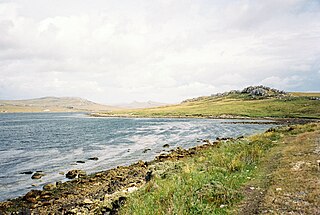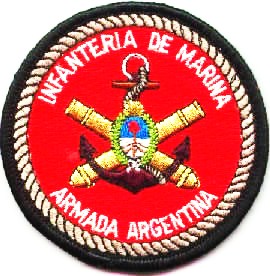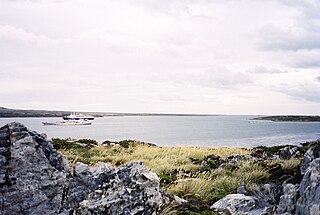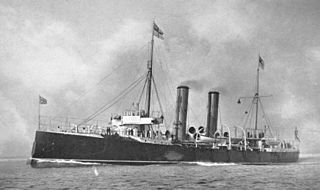
The Falklands War was a 10-week undeclared war between Argentina and the United Kingdom in 1982 over two British dependent territories in the South Atlantic: the Falkland Islands and its territorial dependency, South Georgia and the South Sandwich Islands.

The Battle of Mount Harriet was an engagement of the Falklands War, which took place on the night of 11/12 June 1982 between British and Argentine forces. One of three battles in a Brigade-size operation all on the same night, the other two being the Battle of Mount Longdon and the Battle of Two Sisters.
The Battle of Two Sisters was an engagement of the Falklands War during the British advance towards the capital, Port Stanley. It took place from 11 to 12 June 1982 and was one of three battles in a Brigade-size operation all on the same night, the other two being the Battle of Mount Longdon and the Battle of Mount Harriet. Fought mainly between an assaulting British force consisting of Royal Marines of 45 Commando and an Argentine Company drawn from 4th Infantry Regiment.

The Battle of Wireless Ridge was an engagement of the Falklands War which took place on the night from 13 to 14 June 1982, between British and Argentine forces during the advance towards the Argentine-occupied capital of the Falkland Islands, Port Stanley.

The Battle of Mount Longdon, on 11–12 June 1982 near the end of the Falklands War, was fought between the British Third Battalion, of the Parachute Regiment and elements of the Argentine 7th Infantry Regiment, one of three engagements in a Brigade-size operation that night, along with the Battle of Mount Harriet and the Battle of Two Sisters. A mixture of hand-to-hand fighting and ranged combat resulted in the British occupying this key position around the Argentine garrison at Port Stanley.

The Battle of Mount Tumbledown was an engagement during the Falklands War. Mount Tumbledown, Mount William and Sapper Hill lie west of the Falkland Islands capital Stanley and due to their proximity to the capital, were of strategic importance during the 1982 War. They were held by the Argentine 5th Naval Infantry Battalion, a reinforced, cold weather trained and equipped, Marine battalion.

The 5th Naval Infantry Battalion is a battalion of the Argentine Marines.

East Falkland is the largest island of the Falklands in the South Atlantic, having an area of 6,605 km2 or 54% of the total area of the Falklands. The island consists of two main land masses, of which the more southerly is known as Lafonia; it is joined by a narrow isthmus that was the scene of the Battle of Goose Green during the Falklands War.

Port Howard is the largest settlement on West Falkland. It is in the east of the island, on an inlet of Falkland Sound. It is on the lower slopes of Mount Maria.

The Invasion of the Falkland Islands, code-named Operation Rosario, was a military operation launched by Argentine forces on 2 April 1982, to capture the Falkland Islands, and served as a catalyst for the subsequent Falklands War. The Argentines mounted amphibious landings and the invasion ended with the surrender of Falkland Government House.
This is a list of the ground forces from Argentina that took part in the Falklands War. For a list of ground forces from the United Kingdom, see British ground forces in the Falklands War.

Port William is a large inlet on the east coast of East Falkland island. A strait called "the Narrows" leads into Stanley Harbour.

Sapper Hill (453 ft) is on East Falkland,. located just south of Stanley, the Falklands Islands capital. It is named after a troop of sappers who were once billeted at Moody Brook barracks.

Duplicate: List of Falkland Islands-related topics

The Assault on Mount Kent was a series of engagements during the Falklands War, primarily between British and Argentine special forces.
The 601 Commando Company is a special operations unit of the Argentine Army.
RAF Navy Point was a Royal Air Force base in the Falkland Islands. Set on a peninsula on which Canopus Hill, Stanley Airport and Gypsy Cove lie, together with a narrow spit of land known as Navy Point, which effectively divides Port William from Stanley Harbour. A small detachment of RAF SAR Helicopters of No. 1564 Flight RAF were based here until the Detachment was moved to RAF Mount Pleasant when the new base opened.

The South East Coast of America Station was a formation of the Royal Navy which existed from 1838 until just after the end of the 19th century.

MS Europic Ferry was a roll-on/roll-off car ferry built in 1967 by Swan Hunter for the Atlantic Steam Navigation Company (ASN). She was acquired by European Ferries in 1971 when they took over the ASN and served with them under the Townsend Thoresen branding. The Europic Ferry was requisitioned by the British government in April 1982 and transported stores, equipment and troops to the South Atlantic during the Falklands War. After the war she returned to service with European Ferries until that company was sold to P&O in 1987. She was sold again to Namora Shipping in 1993 and served on routes in the Mediterranean until sold for scrapping in 2004.













